眼痛が酷くて、夜も眠れないほどです。スマホとパソコンのやり過ぎです。どういうわけか、忘年会のコーディネーター役を3件も仰せつかってしまい、日程調整からお店選び、各人の趣味や好き嫌いによる人選びに至るまで本当に疲れ果てました(苦笑)。
中には、最初のメールでちゃんと店名とその店の「アクセス情報」を含めたリンクまで貼っておいたのに、何回かのやり取りで忘れてしまったのか、「その店はどうやって行けば良いのか?」と言ってくる大先輩まで出現する始末です。もう80歳を優に超えてらっしゃるので仕方がないかもしれませんが、「こっちは眼が痛いんだ、勘弁してくれい」と叫びたくなりました(苦笑)。
巣鴨ときわ食堂
さて、11月19日(水)、この渓流斎ブログではお馴染みのSさんが「巣鴨に登山靴を修理してもらうために、久しぶりに都心に出ますが、渓流斎さん、巣鴨で一緒にランチしませんか?」とのお誘いがあったので、いそいそと出掛けで来ました。
巣鴨といえば、私の母校である大学があった「第2の故郷」みたいな所ですから、案内ならお任せください。しかし、卒業して半世紀近くとなりますと、街並みは激変して、右も左も、全く分からなくなってしまいました。
しかし、ご安心ください。私にはスマホのGoogleマップがある! 私のような方向音痴でも、迷わず目的地に行けます。まずは、所期の目的はランチですから、目指すは、巣鴨地蔵通り商店街にある有名な「巣鴨ときわ食堂 本店」です。大人気店ですから、平日だというのに大行列です。
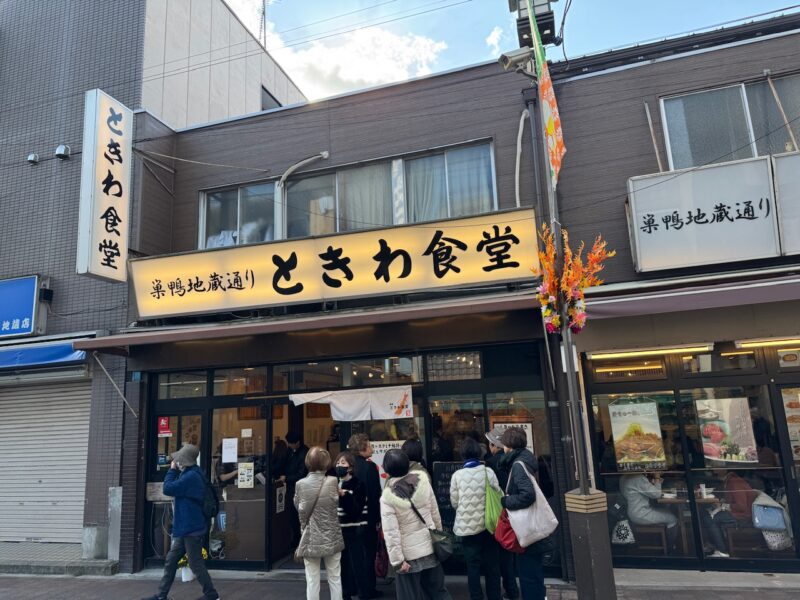
とげぬき地蔵尊 高岩寺
その前に、とげぬき地蔵尊で有名な高岩寺でお参りしました。若い頃は、全く意識しておりませんでしたが、曹洞宗の寺院だったんですね。私が学生時代にもよくお参りしましたが、我々が勝手に「水掛け観音」と呼んでいた観音菩薩様は、「洗い観音」というらしく、今は何と二代目なんだそうです。高岩寺のホームページに「初代は戦前から続く参拝によって摩耗したため、 後方の厨子内に隠退し、平成4年から檀徒 故 中堀義江氏寄進 彫刻家 故 八柳尚樹師制作による二代目に代わりました。それ以降はタワシでなくタオルや手ぬぐいなどで洗うようになっています」と書かれています。
そうでしたか。どうも違う観音さまだなあ、と思っていたら、私の学生時代は、初代の観音さまだったんですね。

「ときわ食堂」では、私は「アジフライ定食」を注文しました。我々が入店する前は、3組ほどしか先客がいなかったので、すぐに入れましたが、席について外を見たら、大行列でした。さすが人気店とあって、メニューも豊富で、サービスも行き届いていました。何遍でも来たくなる定食屋さんでした。
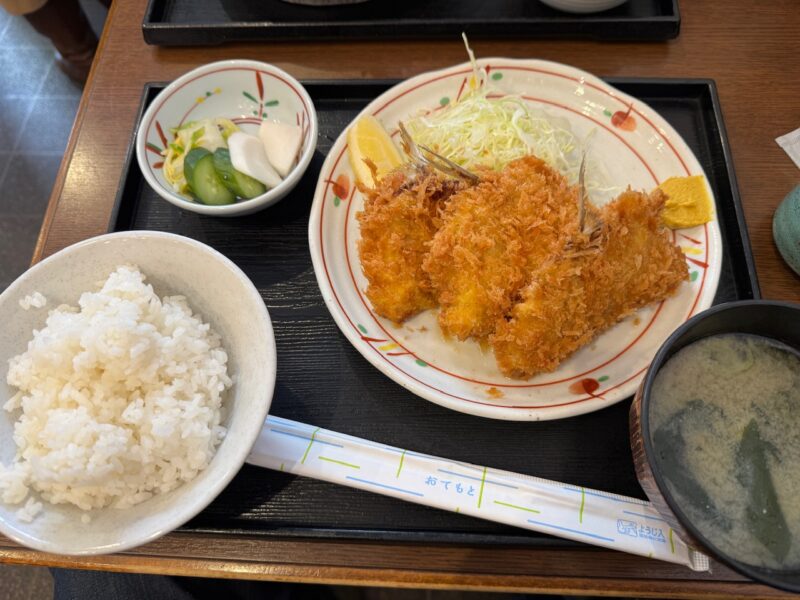
甘味処「榮太楼」
この後、Sさんと一緒に、巣鴨地蔵通り商店街を散策しました。スーパーの進出で、こういう商店街は最近、全国的にも寂れてしまいましたが、残ってほしいものです。以前は「おばあちゃんの原宿」と呼ばれていましたが、今は外国人観光客が目立つ商店街になりました。
フラフラ歩いていたら、「榮太楼」という甘味処があり、美味しそうなお汁粉やあんみつがショーケース並んでいたので入ることにしました。この店は昭和5年創業という老舗で、日本橋の榮太楼本舗と関係があるのか、とSさんが若いお店の女性に聞いたら、「いや関係ないです」とのお答え。一部ネットでは、「日本橋の本店から暖簾分けされた」と書かれたサイトもありましたが、お店の人の言うことですから、そちらが正解なのでしょう。
Sさんは、ぜんざい、私はあんみつを注文しました。それほど広くはない店でしたが、落ち着いた雰囲気で、昭和に戻ったような感覚になれました。
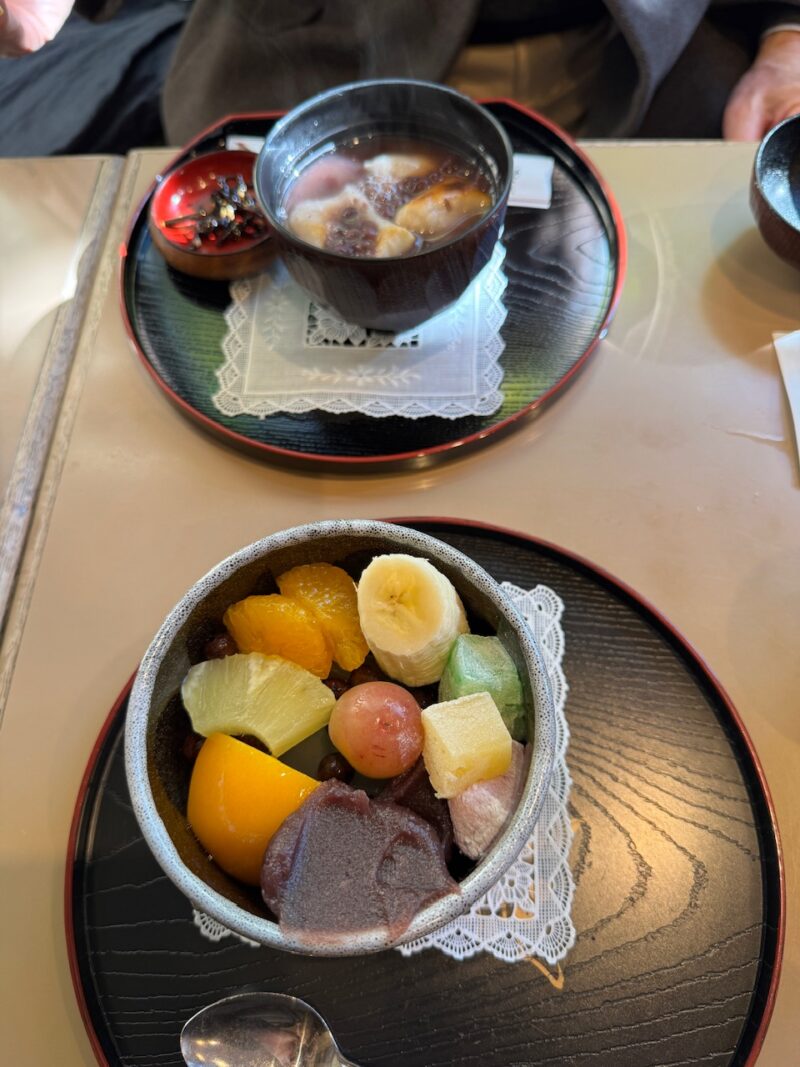
お店を出た途中で商店街の看板地図があり、それを見たら、近くの染井霊園の奥に、遠山金四郎や千葉周作、それに田沼意次のお墓がある寺院があることが分かったので、「行ってみますか」ということで、全く予定も計画もしていなかったのに、行くことにしました。
私は学生時代、染井霊園は「通学路」でした。この霊園には二葉亭四迷や、芥川龍之介、谷崎潤一郎らの墓があり、よくお参りしておりました。また、染井は、江戸時代、植木職人が多く住み、「ソメイヨシノ」を開発したところと聞いていたので、Sさんに話したところ、「へー、そうですか」と感心しながら聞いてくださいました。
でも、この染井霊園の近くに遠山の金さんらのお墓があることは不覚にも知りませんでした。初めて行くところですので、またGoogleマップのお世話になりました。スマホもなく、夜だと必ず迷い人になっていたことでしょう。
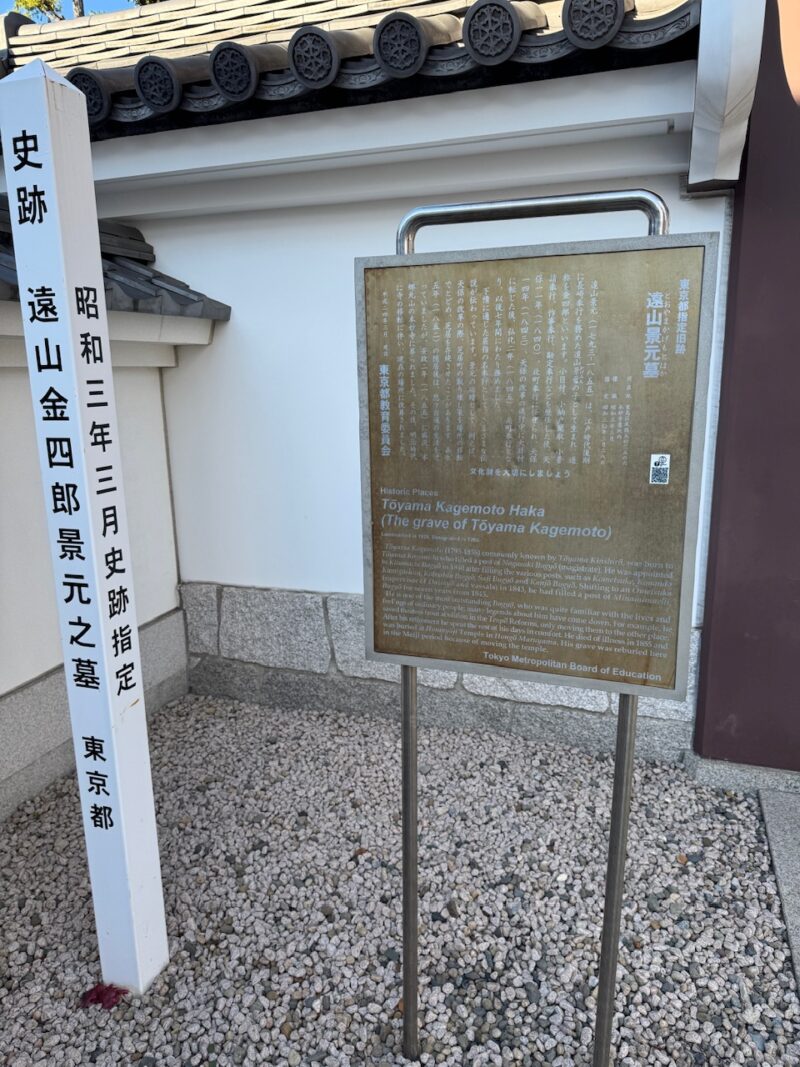
本妙寺
名奉行・遠山金四郎景元と剣豪・千葉周作の墓は、法華宗の本妙寺にありました。このお寺は、徳川家発祥の三河で創建された長福寺の檀徒だった家康の家臣らが智存院日慶商人にお願いして現在の浜松市に元亀2年(1571年)に創建された古刹で、天正18年(1590年)、家康の関東移封で江戸に移転し、市内を何カ所か移建された後、明治になって現在の巣鴨に落ち着きました。

本妙寺には、関宿藩主久世家の歴代の墓や、囲碁の本因坊の歴代の墓、江戸末期の将棋の棋聖位、天野宗歩の墓や、日本最初の通訳、森山多吉郎の墓までありましたから、ご興味のある方はお参りしたら如何でしょうか。
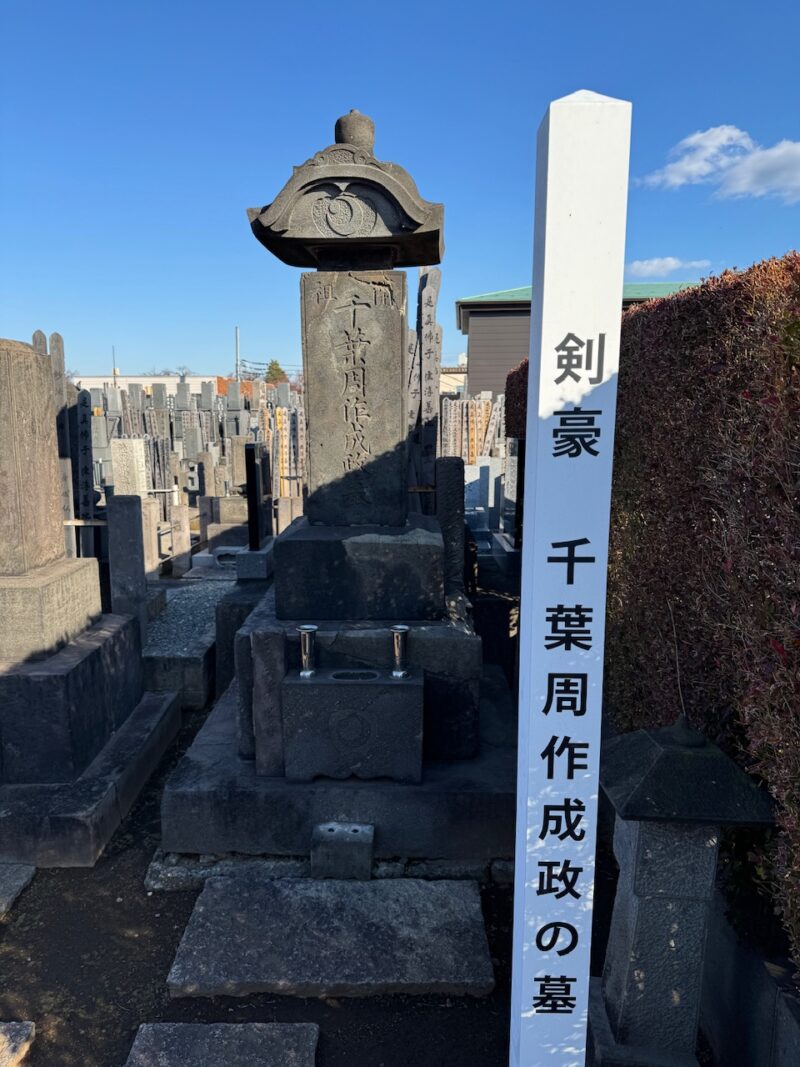
勝林寺 田沼意次の墓
我々は、この後、田沼意次が眠る勝林寺にまで足を伸ばしました。本妙寺から歩いて歩いて5、6分といったところでしょうか。勝林寺は、元和元年(1615年)に創建された臨済宗妙心寺派の禅寺でした。
田沼意次は、今年の大河ドラマで、版元の蔦屋重三郎を主人公にした「べらぼう」でも登場しました。かつては、「賄賂政治」の悪玉として歴史の教科書などで描かれていましたが、最近では評価が変わり、江戸中期の財政と商業を発展させた功労者との見方も出て、ドラマでは渡辺謙が演じ、そのように捉えられていました。
田沼は、将軍に代わって政治を取り仕切る最高権力者の老中という職だっただけに、随分と豪勢で立派な御廟でした。大きさは将軍クラスと言っても良いのではないでしょうか。田沼意次の墓の隣りには、暗殺された息子の田沼意知の墓もありました。
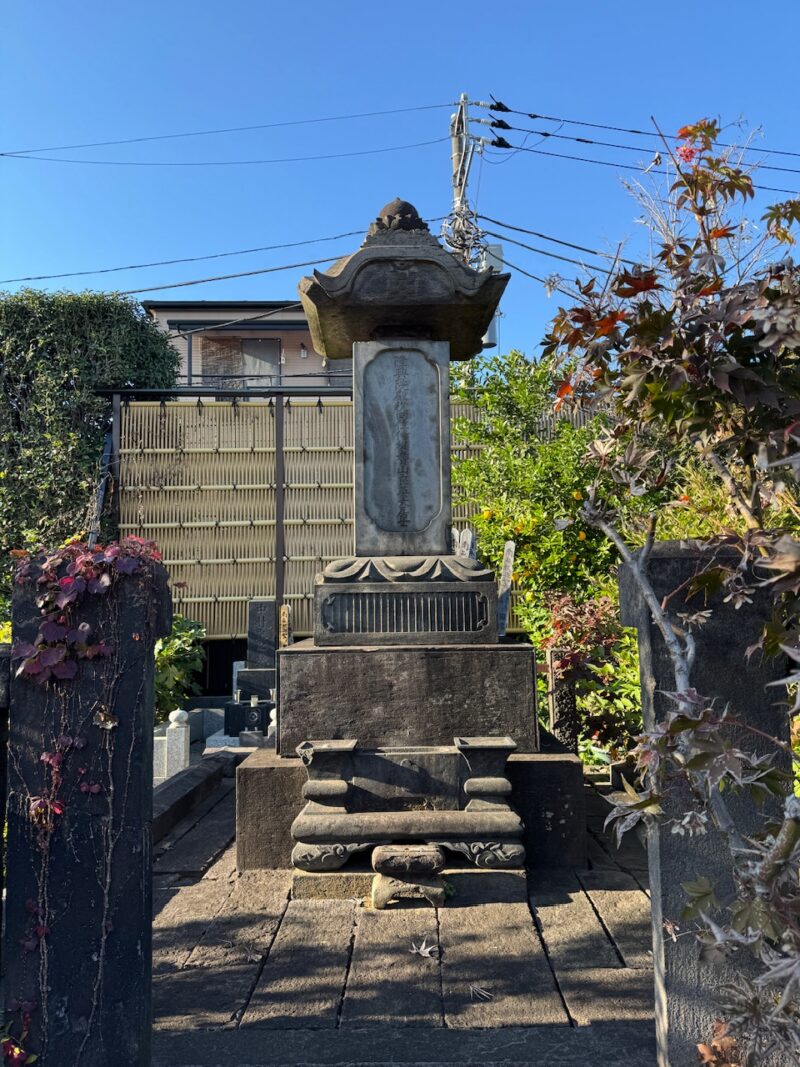
Sugamo, a historic temple district.
I’m suffering from severe eye pain, so much so that I can’t sleep at night. It’s due to excessive use of my smartphone and PC. For some reason, I was asked to coordinate three year-end parties, and I am completely exhausted from handling everything: scheduling, choosing restaurants, and even deciding on the guest list based on everyone’s hobbies and preferences (chuckles).
In one case, I had already included the restaurant name and a link with “access information” in the initial email, but after several exchanges, a senior colleague—who must have forgotten—asked, “How do I get to that restaurant?” Since he is well over 80 years old, I suppose it can’t be helped, but I wanted to shout, “My eyes are hurting, have mercy on me!” (chuckles).
Now, on Wednesday, November 19th, S-san—a regular feature on this Keiryusai blog—invited me out, saying, “I’m heading into the city for the first time in a while to get my hiking boots repaired in Sugamo. Would you like to have lunch together in Sugamo, Keiryusai-san?” So I eagerly went out.
Sugamo is like a “second hometown” to me, as my alma mater was located there, so you can count on me to be your guide. However, nearly half a century after graduation, the townscape has completely changed, and I was completely lost.
But rest assured, I have Google Maps on my smartphone! Even someone with no sense of direction like me can get to the destination without getting lost. Since our primary goal was lunch, we headed straight for the famous Sugamo Tokiwa Shokudo Honten on the Sugamo Jizo-dori Shopping Street. It’s a very popular spot, so there was a huge line even though it was a weekday.
Before that, we paid our respects at the Koganji Temple, famous for the Togenuki Jizo (Thorn-Pulling Jizo). I wasn’t aware of this when I was young, but it is a Soto Zen temple. I often visited it when I was a student, and the Kannon Bodhisattva statue—which we used to call the “Water-Sprinkling Kannon”—is actually called the “Arai Kannon” (Washing Kannon), and I learned that the statue now is the second generation. The Koganji Temple website states: “The first generation was worn down by continuous worship since before the war and has since retired to a reliquary behind the current statue. In 1992, it was replaced by the second generation, donated by the late Yoshie Nakahori and sculpted by the late Naoki Yayanagi. Since then, people have been instructed to wash the statue with a towel or washcloth instead of a scrubbing brush.”
I see. I had thought the statue looked different, and it turns out that I was visiting the first-generation Kannon during my student days.
At Tokiwa Shokudo, I ordered the “Aji-fry Teishoku” (Horse Mackerel Fry Set Meal). When we entered, there were only about three groups ahead of us, so we were seated quickly, but when I looked outside after sitting down, there was a huge queue. As expected of a popular restaurant, the menu was extensive, and the service was excellent. It’s the kind of teishoku restaurant I’d want to visit again and again.
After this, S-san and I strolled along the Sugamo Jizo-dori Shopping Street. Due to the expansion of supermarkets, this kind of shopping street is unfortunately declining nationwide these days, but I hope they will remain. It used to be called “Harajuku for Grandmas,” but now it is a shopping street where foreign tourists are noticeable.
While wandering around, we came across a sweet shop called “Eitaro” and decided to go in because the oshiruko (sweet red bean soup) and anmitsu (agar jelly dessert) displayed in the showcase looked delicious. This shop is a long-established one, founded in 1930 (Showa 5). When S-san asked a young female employee if the shop had any connection to the Eitaro Honten in Nihonbashi, she replied, “No, there is no connection.” Some websites claimed it was a noren-wake (branching off) from the Nihonbashi main store, but we decided the employee’s word must be correct.
S-san ordered zenzai (thick sweet red bean soup), and I ordered anmitsu. The shop was small but had a calm atmosphere, making us feel as if we had stepped back into the Showa era.
On the way out of the shop, we saw a map on a street sign for the shopping district, which showed that a temple containing the graves of Kinshiro Toyama, Shusaku Chiba, and Okitsugu Tanuma was located in the back of the nearby Somei Cemetery. So we said, “Shall we go?” and decided to visit, though it was completely unplanned.
When I was a student, Somei Cemetery was part of my “commute.” I often paid my respects at the graves of writers like Futabatei Shimei, Ryunosuke Akutagawa, and Junichiro Tanizaki there. I also told S-san that Somei was where many gardeners lived during the Edo period and was where the “Somei Yoshino” cherry tree was developed, and he listened with interest.
However, I was unaware, to my shame, that the graves of figures like En’yama no Kin-san were nearby. Since it was my first time going there, I once again relied on Google Maps. Without a smartphone, I would definitely have gotten lost, especially at night.
The graves of the famous magistrate Kinshiro Kagemoto Toyama and the master swordsman Shusaku Chiba were at Honmyoji Temple (Hokke Sect). This temple is an ancient one, founded in 1571 (Genki 2) in present-day Hamamatsu City at the request of Ieyasu’s vassals, who were parishioners of Chofukuji Temple, founded in Mikawa (the birthplace of the Tokugawa family). When Ieyasu was transferred to the Kanto region in 1590 (Tensho 18), the temple was moved to Edo. After several relocations within the city, it finally settled in its current location in Sugamo during the Meiji period.
Honmyoji Temple also houses the graves of the successive lords of the Sekiyado Domain’s Kuze family, successive masters of the Hon’inbo school of Go, Shogi Kisei (Grand Master) Sōho Amano from the late Edo period, and even Tagikichi Moriyama, Japan’s first interpreter. I recommend a visit if you are interested.
After this, we walked to Shorinji Temple, where Okitsugu Tanuma rests. It was about a five or six-minute walk from Honmyoji Temple. Shorinji is a Zen temple of the Rinzai Sect Myoshinji School, founded in 1615 (Genna 1).
Tanuma Okitsugu will appear in this year’s Taiga historical drama, Berabō, which focuses on the publisher Tsutaya Juzaburo. He was once portrayed in history textbooks as the villain of “bribery politics,” but his evaluation has recently changed, with some viewing him as a contributor who developed Edo period finance and commerce. In the drama, he was played by Ken Watanabe and was depicted in this more favorable light.
Given that Tanuma held the position of Rōjū (Senior Council), the highest authority who governed on behalf of the Shogun, his mausoleum was appropriately magnificent and splendid. Its size could even be described as Shogun-class. Next to Okitsugu Tanuma’s grave was the grave of his son, Okitomo Tanuma, who was assassinated.
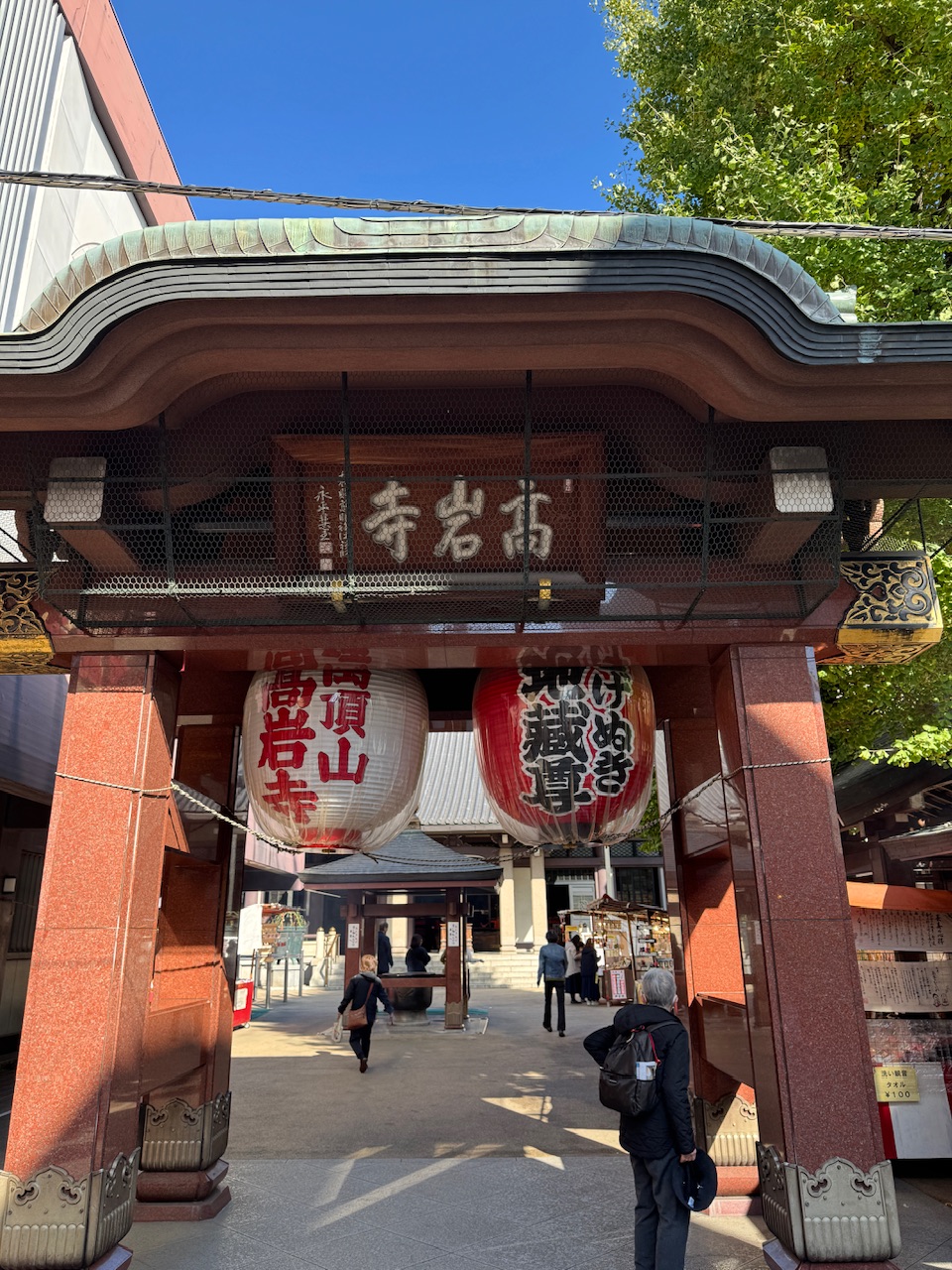

コメント